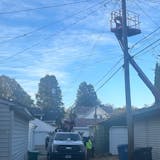John Doe was laid to rest five summers ago, but the search for his identity never died.
The Hennepin County Medical Examiner's Office on Wednesday gave a name and face to the man found dead in a Rosemount railroad shed in September 2014: James Raymond Everett, 48, of Cohocton, N.Y. Everett's widow, Patricia, traveled to Minnesota to meet the strangers who helped bring her closure and held the quiet, somber funeral for her husband in 2017.
"We are incredibly grateful that he was not alone," she said in a statement. "We were always on the lookout for him ... and frequently did a lot of online searching for any indication of activity or other clues as to his whereabouts."
Dedicated Rosemount investigators and medical examiners caught a break from the DNA of distant family members who submitted it to genealogy research. That advancement in technology made it possible to solve the cold case.
But there are some questions for which Patricia Everett and others will never have answers.
Though there is now an official Minnesota death certificate, the cause and manner of his death are undetermined, said chief medical examiner Andrew Baker.
"I'm afraid we'll just never know the answer to that," he said.
As for what James Everett was doing in Rosemount, that also remains unknown.


